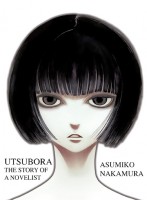 Creator: Asumiko Nakamura
Creator: Asumiko Nakamura
U.S. publisher: Vertical
ISBN: 9781935654766
Released: June 2013
Original release: 2010-2012
Although several of Asumiko Nakamura’s manga have been licensed for digital release, Utsubora: The Story of a Novelist is currently her only work that has been translated into English and made available in print. I truly hope it isn’t the last to be seen from her; although I was already familiar with Nakamura’s distinctive art style, Utsubora was my introduction to her manga and I loved it, and with each rereading love it even more. With the arrival of the Female Goth Mangaka Carnival, I was inspired to take another, deeper look at the manga. In Japan, Utsubora was a short, two-volume series published between 2010 and 2012. The English-language edition of the manga was released in 2014 by Vertical and collects the entire series in a single volume. Due to its mature themes and its erotic content, Utsubora is one of Vertical’s relatively few manga specifically intended for an audience of adults who are at least eighteen years of age.
Although Shun Mizorogi is still considered to be a successful and respected author, it has been quite some time since he has written anything of note. As a result, he has become withdrawn and is tormented by his lack of ability. Finally, his most recent work Utsubora shows great promise. A return to his roots as an author, Mizorogi has given his fans and critics what they have been waiting for. But when a young woman plummets from the top of a building to her death, the apparent suicide somehow connect to Mizorogi, the authorship of Utsubora begins to be called into question. Both Mizorogi’s close friend and fellow author Yatabe and his newly appointed editor Tsuji suspect something. Even Mizorogi’s niece Koyomi, who lives with and adores him, is able to recognize that her uncle has been behaving out of the ordinary. Utsubora and a young woman named Sakura Miki are the only remaining connections Mizorogi has to the death of Aki Fujino, and they are consuming him.
Utsubora is a dark and twisting tale. Nakamura’s distinctive artwork is exceptionally effective in adding to the manga’s moody, erotically charged, and slightly disconcerting atmosphere. The lines of her illustrations are very thin, creating at the same time a sense of sharpness and focus as well as a feeling of softness as they cut and curve across the page. Nakamura’s art in Utsubora is undeniably sensual and arresting. The eyes of her characters are particularly expressive and draw attention to themselves. The artwork of Utsubora, much like the manga’s story, can simultaneously be vaguely ominous and oddly beautiful. It’s really quite stunning and Nakamura is incredibly skilled. Through her artwork and through the body language of her characters, she is able to convey their uncertainties and their desires, their inner turmoil as well as their outward actions. Overall, Utsubora is an intense and even compelling work.
The plot of Utsubora is complex, the relationships and connections between the characters forming a tangled knot that is drawn tighter and tighter. The manga can be confusing and there is quite a bit of ambiguity that is never completely resolved. The only person who really understands everything that is going on is Sakura, and she is deliberately manipulating the situation, mixing together both truths and lies in order to influence those around her. She can’t control everything, though, and some matters in Utsubora are only tangentially related to what she is trying to accomplish. Although sometimes obscured by layers formed by the other characters’ personal struggles and pasts, the core of Utsubora is the despair surrounding Aki, Sakura, and Mizorogi. Granted, most of the characters are reaching their breaking points and are in danger of losing themselves completely; Aki’s death was simply the catalyst that triggered a dramatic sequence of events from which very few will emerge unscathed.

Speak Your Mind